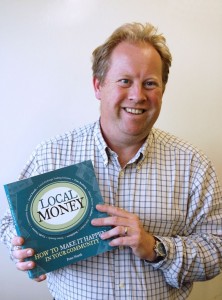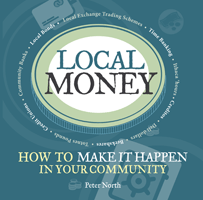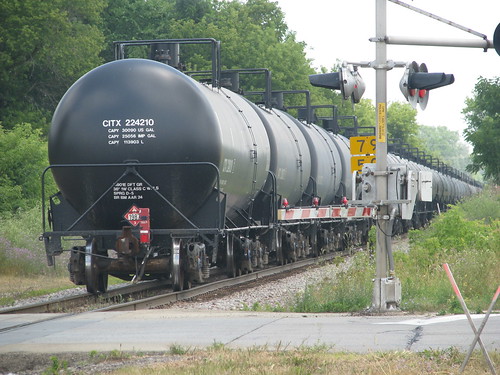Orientation
This issue brief calls for changes in medical school culture, primarily curriculum, research and clinical practice, as a conscious response to the simultaneously ongoing fiscal/economic crisis and what E.O. Wilson has termed the Bottleneck[i] of ecological dilemmas, shown most prominently but not exclusively as the worldwide peak in crude oil production. Together these forces will reconfigure modern society, particularly health care. We concur with Dennis Meadows, co-author of Limits to Growth,[ii] who claims that this is not a recession; rather “The real problem is physical growth in material and energy flows pressing against the limits of a finite planet.”[iii] Therefore, this is a sustainability crisis calling for ecologically informed, non-incremental public policies to transform social institutions.
Here we focus on awakening medical schools to their future in a world beset by fiscal disorder, economic contraction, unprecedented natural resource scarcity, and ecosystems disturbances[iv].
Issue Definition
Modern medicine owes its string of innovations, its health promoting and prolonging successes, and its institutional viability to an economic system based on inexpensive and abundant supplies of crude oil. Oil is a feedstock for a multitude of pharmaceuticals, health commodities and medical products, and is the major source of transportation fuel for staff, patients, emergency vehicles, and equipment and supply deliveries. Oil is also the cornerstone of the modern economy and financial system, a point elaborated below. Thus medicine depends on petroleum both directly, in how it delivers care, and indirectly, because of the modern financial and economic system it enables.
The petroleum era is entering its dénouement concurrently with the largest fiscal and economic crisis since the Great Depression. These two crises are related in that cheap, abundant energy is needed to facilitate capital accumulation and socioeconomic expansion. In terms of finance, “real” wealth creation derives from increasing energy flows, which in turn allow for an economy based upon borrowing and debt repayment while leaving a profit for the borrower. While some may call this connection between finance, economy and energy (primarily oil) speculative or paradigmatically[v] illogical, there is no doubt that work requires energy. Plainly, economic expansion cannot occur without more net energy available to the socioeconomic system –and energy is needed to operate, repair and maintain extant infrastructure[vi].
Significantly, crude oil production has been on a plateau since 2005, known reserves are in decline, and there is no alternative energy infrastructure yet available. The would-be successors to oil: wind, solar, shale gas, biofuels, nuclear, tar sands, and hydrogen, all face one or more of the hurdles of scalability, environmental sustainability, or net sufficient energy return. As well, developing and using these alternatives depends on unknown amounts of fossil fuels, particularly petroleum[vii] and other resources such as land, rare metals, or uranium. Nevertheless, developing alternative energy sources, especially renewable energy sources, such as wind, solar thermal, and photovoltaic, should be pursued with vigor. Even so, these alternatives cannot substitute for oil, let alone replace the decline in production of the oil needed for an industrial economy. They will be essential in helping to develop a sustainable society, but are not a panacea to keep the growth economy going.
Therefore, the lack of an ongoing transition to a new energy platform – estimated to require from 10 to 20 years[viii] — is resulting in a series of downward economic cycles: the cost of energy will rise – due to supply constraints – if real economic growth restarts and then will fall as rising energy costs again destroy demand, creating more economic contraction.
Reaching peak oil also portends the decline of the financial sector -which in the USA has tripled in size since 1980- because it is a credit (debt) based system rendered unworkable by peak oil. We note that as worldwide oil production approached a plateau several years ago the financial sector generated huge debts that without exaggeration cannibalized the “real economy,” culminating in “synthetic instruments” unconnected to any tangible commodity, asset or good[ix]. These fictive debts – and equally chimerical wealth – have not been resolved through disciplined procedures –bankruptcy, write-offs, jubilee, shareholder losses, governmental or regulatory agency seizure of assets, criminal prosecutions – but instead have been transferred to sovereign states. This postpones a cultural, economic, and political realization that money is a symbolic claim on energy and other resources. Bluntly, you cannot eat currency or burn it in your gas tank, and printing more of it exacerbates the dilemma. Eventually the discrepancy between “paper wealth and debt” and the earth’s resources must be acknowledged if we are to realize that this is a sustainability crisis.
When this occurs it will become apparent that viable solutions originate from understanding how the earth’s resources and ecosystems set the bounds of finance[x]
and the economy[xi]. In other words, if energy scarcity is acting as a governor on economic expansion, then the so-called Keynesian solution of printing money to “stimulate the economy” no longer works.
Issue History and Context
In 1957 Admiral Hyman Rickover informed a medical convention in Minneapolis that if a conversion away from fossil fuels were not completed within fifty years socioeconomic and financial turmoil would result[xii]. Similarly, Shell Oil geologist M. King Hubbert[xiii] told a conference of his peers in 1956 that oil production in the lower 48 states, then rising, would peak between 1965 and 1970. He was ignored and ridiculed, but in 1970 “peak oil” occurred as predicted. Hubbert’s intellectual descendant Princeton geologist Ken Deffeyes[xiv] claims that world production peaked in 2005, and he has also forecast that the peak would lead to disarray in financial markets and widespread unemployment. Geologist Colin Campbell has made the same observation about the economic and financial consequences of peak oil[xv]. (Thus geologists foresaw what almost all mainstream economists did not.)
However, the demand destruction for oil during the fiscal/economic crisis that began in 2007 has co-varied with this production peak, suggesting it is still not certain that the worldwide peak has been reached. Nonetheless, we are certain that peak oil, finance and the economy are connected in a little explored complex of feedback loops[xvi], which are further complicated by cultural constants – corruption, herd behavior, inertia for institutional stability[xvii], and greed – and also geopolitical relations among nation states vying for oil and other resources.
Therefore, we propose that: 1) the energy crisis –if not the actual geological peak in oil production[xviii]- is here, and not years in the distance; 2) it is affecting the economy, the financial system, and our place in the world; and 3) we are slow to acknowledge its reality and to plan a response.
The thought of civilization’s material existence declining as opposed to becoming “bigger and better” is anathema to university presidents and medical faculty deans, to say nothing of philanthropic sponsors, politicians, corporations, and the mainstream media. Inversely, once the end of growth is accepted, building a sustainable society will be the obvious response -but we acknowledge that belief in perpetual growth is deep-seated, even mythical[xix]. As one observer puts it, “Eaarth itself will be th[e] ecological Lenin, a harsh environmental dictator that will force us to bend to new rules. The question is whether we will be smart enough to bend ourselves first.”[xx]
Still unbending, the world economy nevertheless is stochastically contracting, and this translates into two classes of effects on the health sciences:
1. The social determinants of health are placed at risk of precipitous decline, and this carries immense epidemiological implications; and,
2. Less appreciated, health systems eventually will be unable to maintain current levels of operations, specifically their social and technological complexity and levels of resource consumption will have to be reorganized or face collapse.
Issue Analysis:
Toward Sustainable Medical Schools
Rather than give detailed consideration to medical research and clinical practice, we focus here on medical school curriculum as our primary example. Accepting that we face a sustainability challenge as opposed to a recession, medical education has the paradoxical tasks of: 1) training current students to practice medicine in today’s socially and technologically complex and high resource consumptive world while simultaneously 2) building a bridge to a world all but guaranteed to shrink these levels of complexity and consumption. This is especially vexing because we do not know how much loss of complexity and lowering of consumption are required –that is, the definition of sustainable medicine is in flux and depends upon an interplay of ecological, economic and fiscal forces.
Presently, there are no medical schools we are aware of dealing with this conundrum[xxi]. But the school(s) that ultimately creates a paradigm of sustainable medicine will be advantaged in terms of organizational survival, clinical practice, research–both agenda setting and funding streams – and plaudits for vision and leadership. Moreover, there is an opportunity – and a strategic imperative – for medicine to lead in advocating for a sustainable society as a matter of public health and social responsibility, and as a model for other institutions in society.
Following innovation theory,[xxii] approximately 2% of a given universe -in this case, schools of medicine- can be expected to take on this unprecedented challenge. Since the sustainability crisis ostensibly is high in present costs with few or no immediate benefits, even this 2% may be too high an estimate. Moreover, risk aversion or miscalculation of risk among leaders[xxiii] accounts for significant resistance to innovation, especially an innovation that results in less complexity and resource consumption[xxiv]; this is a paradigm shift that is truly of Kuhnian magnitude. Ironically, any medical school deans who would pursue sustainability as outlined here would likely encounter strong opposition from their faculties, the medical establishment, and administrative superiors, although there is hope as more and more universities are promoting sustainability as part of their corporate image and also their educational curricula –and medical students will be enthusiastic about sustainability. While it is possible, even likely, that the change in medical culture may not come from schools of medicine, but from practitioners in the field, we feel that, given the serious and imminent nature of the problem, such a passive approach is unacceptable and medical schools must acknowledge the problem and begin to act.
In terms of risk assessment we take a “strong position” that the arrival of peak oil means there is a probability of 1 that medicine schools must become sustainable or face chaotic change. The standard risk assessment formula is R = ƒ(H · V), where R is hazard risk, H is hazard probability, and V is hazard vulnerability. The immediate hazard, H, in our case is “peak oil.” While its timing is in doubt, the evidence cited above suggests it has occurred or will occur within five years. The actual timing is irrelevant because the era of cheap energy facilitating economic growth is irretrievably over.
Energy is not the only ecological risk we face; it is merely the most pressing and unavoidable one because of its interaction with all aspects of our society; it is perhaps the most important component of our infrastructure. Down the road are intensifying consequences of climate change, ecosystems insults and degradations, water scarcity, soil erosion, dying and overfished oceans, and even peak phosphorous,[xxv] to name a few.
The purpose of strategic management – for which risk assessment is a tool – is to ensure the survival of the organization by aligning it with the external environment, particularly during periods of high uncertainty, turbulence or chaos. We conclude by assessing medical school reform in this context.
Policy Discussion
As a reference point, Hanson and Callaghan[xxvi] list four core goals of medicine:
The prevention of disease and injury and the promotion and maintenance of health;The relief of pain and suffering;The care and cure of those with a malady, and the care of those who cannot be cured; andThe avoidance of premature death and the pursuit of a peaceful death.
Important to our discussion, they note that medicine has become reductionist in its approach to illness while diminishing the importance of the natural and social environmental contexts of health promotion and illness prevention. This “invasive microbes” model translates into the basic science classes of the first two years of medical school followed in the third and fourth years by clinical experience, field of specialization classes, and electives. With few exceptions, this is the standard curriculum, and it emphasizes resource-intensive treatment over less resource-consumptive preventive health care. Significantly, it also dominates the medical research agenda.
We propose a fifth goal be integrated into medicine: the practice of supply-side sustainability,[xxvii] which recommends management from the perspective of the whole ecosystem, not the resource[xxviii]. In other words, we must consider how human health fits in the context of overall ecosystem health, or, more bluntly, when we must forgo human health so as to ensure a viable biosphere within which humanity can sustain itself indefinitely. The ramifications of this goal will jar many in academic medicine who are engrossed in their specialties and regard the larger systems that support their work as a perpetual motion machine that cannot falter.
Consider that Hanson and Callaghan’s four goals reflect a modern interpretation of the Hippocratic Oath, which values the patient ahead of, or to the exclusion of, all other concerns, especially resource consumption and environmental impacts. But, in view of the ultimate dependence of all life on a healthy ecosphere, and also because many of the resources we use – oil, water, minerals – are depleting, such concerns must be considered. One definition of sustainability is: “… the process of living within the limits of available physical, natural and social resources in ways that allow the living systems in which humans are embedded to thrive in perpetuity”[xxix]. Many would argue that following a lifestyle based on this definition is unrealistic, but, in the long run, we have little choice; today’s lifestyles are clearly unsustainable, and ultimately disastrous. Certainly today’s health care system does not fit with this definition; yet, ultimately it too must conform, and the transition from the current model to a sustainable health model will be difficult.
In a sustainable health system the supremacy of the patient must be synthesized with an “Ethics of Environmentally Responsible Health Care”[xxx]. We cannot digress into this discussion here except to note that it calls for discourse in medical ethics and bioethics that overcomes the dualisms implicit in the received interpretation of the Hippocratic Oath; i.e. the sanctity of the patient versus (a) social factors and (b) ecological constraints, priorities, and impacts. This raises major ethical, social, political, and cultural issues that will result in a fervid discussion that goes to the heart of the current paradigm of academic medicine[xxxi]. For example, today’s medical ethics is set in a framework of an expanding macro-economy providing a bounty of resources to support problem solving that increase social and technological complexity and energy consumption.[xxxii] But supply-side sustainability requires “innovation” and problem solving in a macro-economic context of less complexity and resource scarcity.
To this end, we note several recent reports on medical curricula.[xxxiii] Without exception these reforms presuppose a patient-focused model of care and linear expansion of medicine’s social and technological complexity, resource consumption, and, it logically follows, its physical size. We respectfully find these reports out of sync with the strategic mandate to build sustainable health systems. However, taking a baby and the bath water approach, our views are consistent with and complement many of the proposed reforms in these reports, which we do not have the space to discuss here.
A comprehensive goal of medical school reform should be to introduce students to the idea of health systems functioning in accord with supply-side sustainability, which, according to Allen et al, is:
more fundamental than mere exhortations to do such and such things as use public transport and take colder showers. Sustainability entails management of systems and their contexts…[xxxiv]
We propose to redefine the medical context as a part of nature, with human species’ survival depending on the continued availability of essential renewable resources, which in turn depend on healthy natural ecosystems.
The context of supply-side sustainability is related to the ecological theory of panarchy, “the hierarchy of adaptive [ecological] cycles … across time/space scales.”[xxxv] We see panarchy[xxxvi] as a scientifically grounded and concise way to illustrate that modern economies are at the apex of the exploitation of natural resources cycle – oil and other resources now becoming scarce, environmental degradation mounting – that has allowed for the phenomenal successes and growth of modern medicine and public health. This gives way to its successor ecological phase (an emerging context), resource exhaustion, pollution, ecosystem breakdowns, which leaves our species with the options of (a) acknowledging our predicament and beginning immediately to adapt to a simpler, more sustainable, lifestyle, (b) maintaining Business As Usual. Unfortunately, the second option will most likely win out in the short-term. For medical education (and health care), the same issues, options, and urgencies apply.
In summary, medical school graduates will need to value resource conservation and ecological processes equally to the rights of the individual patient. It is imperative that their education prepares them for their role as a historically transitional generation called upon to relinquish levels of social and technological complexity and, in addition to the scientific knowledge that forms the basis of medicine, to also draw upon tactile and tacit knowledge gained during their careers. An example helps make this point.
A recently retired doctor informs me, “In orthopedics we used to set fractures mostly by feel and knowing the mechanics of how the fractures were created. I doubt that many of the present orthopedists could do a good job if you took away their [energy powered] fluoroscope or X-ray.”[xxxvii]
Policy Recommendations
Based on the arguments presented, we feel that the concepts of supply-side sustainability should be incorporated into the three primary dimensions of medical school culture: curriculum, clinical care, and research; and to also communicate this reorientation to the larger society, through “Social[xxxviii] Marketing”[xxxix] and “Branding”.
A simple outline is presented below; it is less of a map than it is a stone in our shoe moving us to action.
1. Curriculum.
i. Supply-side sustainability built into all courses.
ii. Develop a capstone course on “sustainable health care in the 21st century”.
iii. Elevate preventive medicine to equal status with treatment medicine.
2. Clinical.
*Develop scenarios of resource conservation for medical practice.
i. 15% reduction of use
ii. 25% reduction of use
iii. 50% reduction of use
3. Research.
i. Develop a research agenda anchored in the protection of the social determinants of health.
ii. This research agenda’s rationale is based on the epidemiological shifts brought on by economic contraction.
4. Use “Branding” and Social Marketing to promote the medical school as meeting the 21st century necessity to create sustainable health systems.
Endnotes
[i] Wilson, E.O. “The Bottleneck.” Scientific American, February 2002.
[ii] Meadows, Donella. Dennis Meadows, Jorgen Randers, William Behrens III. The Limits to Growth. New York: Universe Books. 1972.
[iii] Meadows, Dennis. “Economics and Limits to Growth: What’s Sustainable?” Conference on Population Growth and Rising Consumption: What’s Sustainable?” The Population Institute. October 6, 2009. http://populationinstitute.org/newsroom/events/view/5/
[iv] Cohen, Dave. “The Sixth Extinction.” ASPO. July 30, 2009. http://www.aspousa.org/index.php/2009/07/the-sixth-extinction/.
[v] Kuhn, Thomas. The Structure of Scientific Revolutions. Chicago: University of Chicago Press. 1962.
[vi] Hall, Charles Hall, R. Powers and W. Schoenberg. (in press). “Peak oil, EROI, Investments and the Economy in an Uncertain Future.” Pp. xxx in Pimentel, David, ed. Renewable Energy Systems: Environmental and Energetic Issues.
[vii] See the writings of Gail Tverberg: http://www.theoildrum.com/search/google?cx=000874532052579887663%3Amezzmhxsexy&cof=FORID%3A11&query=tverberg&op=Search&form_build_id=form-b8dda647e69bbc6929a3ece6d0750c62&form_id=google_cse_results_searchbox_form.
[viii] Hirsch, Robert L. Roger Bedzek and Robert Wending. “The Hirsch Report” AKA “Peaking of World Oil Production: Impacts, Mitigation, & Risk Management.” Washington: US DOE, February 2005.
[ix] Sender , Henry, Francesco Guerrera, Stephanie Kirchgaessner. “Goldman вЂcriticised $1bn loan product’.” Financial Times, April 27, 2010. http://www.ft.com/cms/s/0/f144793c-518c-11df-bed9-00144feab49a.html.
[x] Soddy, Frederick. The Role of Money: What It Should Be, Contrasted with What It Has Become. New York: Harcourt, Brace and Co, 1935.
[xi] Mayumi, Kozo, and John M. Gowdy. Bioeconomics and Sustainability: Essays in Honor of Nicholas Gerogescu-Roegen. Cheltenham, UK: M.A. Elgar. 1999.
[xii] Rickover, Hyman. “Energy resources and our future.” Delivered at a Banquet of the Annual Scientific Assembly of the Minnesota State Medical Association, St. Paul, Minnesota. May 14, 1957. http://www.energybulletin.net/node/23151.
[xiii] Hubbert, M. King. “Nuclear energy and the fossil fuels.” Presented at the Spring Meeting of the Southern District Division of Production American Petroleum Institute Plaza Hotel, San Antonio, Texas March 7-8-9, 1956.
[xiv] Deffeyes, Kenneth S. Beyond Oil: The View from Hubbert’s Peak. New York:Farrar, Straus and Giroux, 2005.
[xv] Campbell, Colin. “Peak Oil: A turning for mankind.” Great Change.org. ND. http://www.greatchange.org/ov-campbell,peakoil_turning_for_mankind.html.
[xvi] Tverberg, Gail. “Why are oil prices so low?” The Oil Drum, October 22, 2008. http://www.theoildrum.com/node/4672.
[xvii] Douglas, Mary. How Institutions Think. Syracuse: Syracuse University Press. 1982.
[xviii] Staniford, Stuart. “If 2005-2007 wasn’t peak oil, what was it?” Early Warning: Risks to Global Civilizagtion. April 212, 20120. http://earlywarn.blogspot.com/2010/04/if-2005-2007-wasnt-peak-oil-what-was-it.html.
[xix] Catton, William Jr. Overshoot. Urbana: University of Illinois Press. 1982.
[xx] Greenberg, Paul. “Hot Planet, Cold Facts.” Review of Bill McKibbon’s Eaarth:Making a Life on a Tough New Planet.New York Times, April 29, 2010. http://www.nytimes.com/2010/05/09/books/review/Greenberg-t.html.
[xxi] Homer-Dixon, Thomas. “Our Panarchic future.” Worldwatch Institute. February 2008. http://www.worldwatch.org/node/6008.
[xxii] Rogers, Everett M. “Diffusion of Innovations. 1962.
[xxiii] Kahneman, Daniel, and Amos Tversky (1979) “Prospect Theory: An Analysis of Decision under Risk”, Econometrica, XLVII (1979), 263-291.
[xxiv] Staff. “Innovation hampered by ‘risk averse’ public authorities.” Eur-activ.com. March 24, 2010. http://www.euractiv.com/en/enterprise-jobs/innovation-hampered-risk-averse-public-authorities-news-373313.
[xxv] Déry, Patrick and Bart Anderson. “Peak Phosphorous.” Energy Bulletin. August 13, 2007. http://www.energybulletin.net/node/33164.
[xxvi] Hanson, Mark J. and Daniel Callahan, eds. The Goals of Medicine: The Forgotten Issues in Health Care Reform. Washington, D.C.: Georgetown University Press, 1999.
[xxvii] Allen T.F.H., Joseph A. Tainter, and Thomas W. Hoekstra. Supply-Side Sustainability. New York: Columbia University Press. 2003.
[xxviii] Allen, T.F.H., Joseph A. Tainter, and T.W. Hoekstra. Supply-side Sustainability. Systems Research and Behavioral Science, 1999, 16:403-427.
[xxix] University of Alberta Office of Sustainability. Working Definition. Spring 2010. www.sustainability.ualberta.ca/.
[xxx] Pierce, Jessica, and Andrew Jameton. The Ethics of Environmentally Responsible Health Care. New York: Oxford University Press. 2004.
[xxxi] Staff. “The culture of medicine.” Science Daily, January 5, 2009. http://www.sciencedaily.com/releases/2008/12/081231182014.htm.
[xxxii] Tainter, Joseph A. “Social Complexity and Sustainability.” Ecological Complexity 3 Pgs. 91-103, 2006: 93.
[xxxiii] Greiner, Ann C. and Elisa Knebel, Eds, Health Professions Education: A Bridge to Quality. Institute of Medicine, 2003.
Task Force on Academic Health Centers. Training Tomorrow’s Doctors: The Medical Education Mission of Academic Health Centers. Commonwealth Fund. 2002.
Ad Hoc Committee of Deans. Educating Doctors to Provide High Quality Care: A Vision for Medical Education in the United States. American Association of Medical Colleges. 2004.
[xxxiv] Allen T.F.H., Joseph A. Tainter, and Thomas W. Hoekstra. Supply-Side Sustainability. New York: Columbia University Press. 2003: Pg. 14.
[xxxv] Biocultural Diversity Learning Network. “Panarchy.” Global Diversity Fund. 2010. http://www.globaldiversityfund.net/glossary/1/letterp.
[xxxvi] Gunderson, Lance, and C.S. Holling, eds. Panarchy: Understanding Transformations in Human and Natural Systems. Washington, D.C.: Island Press. 2002.
[xxxvii] Bednarz, Dan. “Medicine after Oil.” Orion Magazine, July/August 2007. http://www.orionmagazine.org/index.php/articles/article/314/.
[xxxviii] Zaltman, Gerald, and Lindsay Zaltman. Marketing Metaphoria: What Deep Metaphors Reveal about the Minds of Consumers.Boston: Harvard Business Press. 2007.
[xxxix] Kottler, Philip, and Gerald Zaltman. “Social Marketing: An Approach to Planned Social Change.” Journal of Marketing, July 1971, Vol. 35: pg. 3-12.
Health reform means big changes for businessesForever and a day





